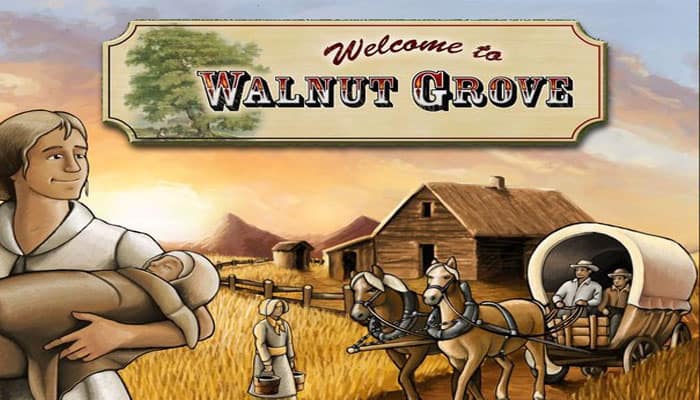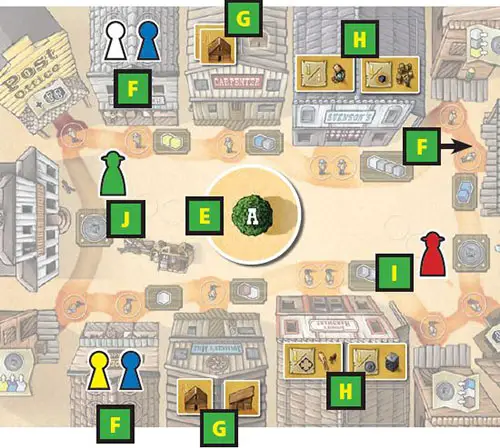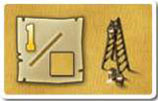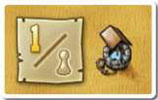
The year is 1885. Thanks to the American government making more land available in the Midwest, you and your wife have managed to obtain a small homestead and build a little house on the prairie.
The neighboring town of Walnut Grove can provide everything you need to ensure that your little prairie farm thrives. Winters are harsh, so make sure you have enough food to eat and wood for heat! Who will be the most successful settler?
Components

- 1 game board
- 4 player boards
- 50 land tiles
- 8 building tiles
- 21 improvement tiles
- 7 neighborly help tiles
- 30 cardboard coins
- 8 year disks
- 130 wooden cubes
- 24 wooden pawns
- 1 large linen tile bag
- 1 small linen coin bag
- rulebook
Object of the Game
Walnut Grove is played over 8 rounds, each of which represents one year. Players try to expand their farms as successfully as possible. Final scoring takes place after the last round of the game. The player with the most victory points is the winner.
Setup
-
Give each player a random player board, which they place in front of themselves. Additionally, give each player:

1 black farmer and either one blue or one yellow laborer
A(depending on the color of the first covered wagon on the player's board), to be placed onto the player board.2 copper coins
B, to be placed onto the first two barn spaces on the player board, as well as one brown cubeC("wood"), to be placed onto one of the square storage spaces in the wood district in the upper right hand corner of the player board.1 colored player figure (with a hat)
D, to be placed onto the town board.
-
Put all landscape tiles into the large bag, and all remaining coins into the small bag.
-
Separate the year discs into A and B piles and then shuffle them separately. Place the pile of B discs, face down, in the middle of the town board
E. Place the face down pile of A discs on top of them. Turn the topmost disc face up.
-
Randomly distribute the remaining white, blue and yellow laborers onto the Hotel, Saloon and Lodge as follows:
- 2 laborers per building with 1-2 players
F - 3 laborers per building with 3 players
- 4 laborers per building with 4 players
- 2 laborers per building with 1-2 players
-
Shuffle up the building tiles and randomly distribute them onto Johansen's Mill and the Carpenter as follows:
- 2 tiles per building with 1-2 players
G - 3 tiles per building with 3 players
- 4 tiles per building with 4 players
- 2 tiles per building with 1-2 players
-
Shuffle up the improvement tiles and randomly distribute them onto Svenson's and Soebuck's as follows:
- 2 tiles per building with 1-2 players
H - 3 tiles per building with 3 players
- 4 tiles per building with 4 players
- 2 tiles per building with 1-2 players
-
Place the goods cubes (yellow=grain, blue=fish, white=dairy, brown=wood, grey=stone) and the neighborly help tiles next to the town board.
-
Return any unused playing pieces and tiles to the box.
The youngest player begins. In clockwise direction, each player chooses either the Church I or the Town Hall J and then places his player figure onto an empty starting space in front the chosen building. Spaces must be filled in order, starting with the space closest to the street running around town.
Game Play
The game is played over eight rounds, each of which represents one year. Each year is made up of four seasons, carried out one after the other by the players. Different actions are carried out each season:
- Spring New additions: Players expand their farms by drawing landscape tiles and adding one or two of them to their holdings.
- Summer Work and harvest: Players place their farmers and laborers onto their land and produce goods.
- Fall Business in town: Players move their playing figures around town and use the action of the building they moved to.
- Winter The cold season: Farmers and laborers come home cold and hungry. They need food and warmth.
Note: Players can carry out the spring, summer and winter seasons simultaneously. Fall is the only season where turn order is important.
Spring
Players expand their farms in the spring.
Each player:
draws as many landscape tiles from the bag as indicated by the number in the spring (violet) section of the year disc (2, 3 or 4 tiles).
chooses as many tiles from those drawn as indicated (1 or 2) and places them adjacent to either his player board or previously-placed landscape tiles.
returns the rest of the tiles to the bag.

Note: Landscape tiles have three attributes: landscape types, fences and available production spaces. You do not need to place them such that all landscapes and fences match up, but there are benefits for doing so.
The first tile you place must be placed adjacent to one of the five landscapes shown on your player board; later tiles must be placed adjacent to either your board or previously-placed landscape tiles.
Summer
Players use their farmer and laborers to work and harvest in the summer:
-
Each player places each of his farming figures onto a land area. Land areas are made up of one or more landscapes of the same type. They can be as small as a single field or span far and wide. Players may also use the landscapes on their player boards.
Note: You can only place one figure per land area. You can have multiple figures on the same landscape tile, provided that they are all in different land areas. You can also place figures onto multiple land areas of the same color The colors of the land areas and the figures placed onto them do not need to match.
-
Farmers and laborers immediately produce goods from the landscapes they were placed onto. Each figure produces as many goods as the number of tiles the land area it is on is made up of. Landscapes on player boards count as well.
The summer section of the year disc indicates which good experiences bonus production this year - each figure in a matching land area produces one additional good.

Example: The yellow laborer is working in a size 1 forest area and therefore only produces a single brown good, placed onto one of the two empty storage spaces. The blue laborer is on a size 3 pasture and would normally produce 3 white goods.
Since white is the bonus production good this year, he produces 4 instead. As there are only 3 storage spaces in the land area, the fourth good gets placed in the barn. The black farmer harvests 3 yellow goods, placed onto the empty storage spaces.
Take the goods from the supply and immediately place them onto the empty storage spaces of the corresponding land areas. Each storage space has room for one good.
Should all land area storage spaces be filled, then you may place the rest of the goods onto empty barn spaces on your player board. You may return coins or goods from your barn at any time to make room for new goods. Any goods you do not have room for are lost and returned to the supply.
Note: You may move goods from land areas to your barn at any time. However, you may NOT move goods from your barn back out to land areas again. You may also NOT move goods between land areas of the same type.
Hint: In fall and winter, it is better to use goods stored in your barn first and then use goods out on land areas second.
Fall
Players move around the city in the fall, selling goods, hiring laborers and buying building materials.
1 Player order in the fall is determined by the position of the playing figures on the game board: The player whose figure is the furthest away from the town hall (in clockwise direction) goes first, followed by the other players according to the positions of their figures.
In the first year, the player whose figure is on the first starting space in front of the church goes first.
2 On your turn, move your figure along the street to the unoccupied building of your choice and then carry out the action available there. Should the building require an activation cost (indicated by the wooden sign in front of it) then you must pay those costs.
If you cannot pay the costs, then you cannot move to the building. Use the building action exactly once. It is then the next player's turn to move and use a building, etc.
Note: You are allowed to move around the entire town, ending up on the same space you started on. You can also choose to pass. In that case, you do not move your figure and cannot use the building action of the building you are in front of.
You cannot use any buildings occupied by other players. Svenson's and Soebuck's are the exception, as they have room for two figures.
3 Taxes & 4 Church Bazaar: When you move your figure past either the Town Hall or the Church Bazaar, you must pay one coin (of any value) from your barn. If you cannot pay (or do not want to pay), take a neighborly help tile from the supply instead and place it in front of you, "3 goods" side up.

You can return the tile at any time by also returning any 3 goods to the supply. Should you take another neighborly help tile later in the game, then also flip the first tile (that hasn't been paid back yet) over - it can now no longer be returned.
This means that you will never have more than a single returnable neighborly help tile at any time. Any flipped-over neighborly help tiles you have at the end of the game are worth -2 points each.

There are five different building types, each with different actions:
A Post Office & Church: You receive two free goods. Take any two goods from the supply and place them in your barn.
B Lodge, Hotel, Saloon: Pay the building cost and choose one of the available laborers, placing him NEXT to your player board. The new laborer only enters the game AFTER winter (which means that you will not need to supply food and firewood for him this year).
C Carpenter & Johansen's Mill: Pay the building cost and choose one of the available building tiles (hut or barn). Place the tile onto the matching space on your player board. The barn increases your goods storage capacity by two, while the hut reduces your heating requirements in the winter.
D Svenson's & Soebuck's: Pay the building cost and choose one of the available improvement tiles. Place the tile onto a matching space on your player board. Improvement tiles provide additional victory points at game end.
E General Stores: Sell one of each indicated goods type (a total of up to three goods). Take the goods from your barn or from land area storage spaces and return them to the supply.
Draw one random coin from the bag for each sold good, placing them in your barn, face-down. Any coins you do not have room for must be returned to the bag. Should you sell the good indicated by the fall section of the year disc, then you receive an additional coin.

(In the example shown, selling a brown good would gain you 2 coins).
Winter
Players' farmers and laborers return home to their huts and campfires in the winter. Each player must now:
-
feed his laborers:
Each laborer eats one good of the matching color. So a yellow laborer needs a yellow good (grain), a blue laborer needs a blue good (fish), and a white laborer needs a white good (dairy). Farmers have enough to eat at home and don't need to be fed.
Each laborer normally requires 1 good. However, each laborer of the color indicated by the winter section of the year disc will require 2 goods instead.
Take the goods from your barn or from land area storage spaces and return them to the supply. If you do not have enough food to feed your laborers with, then you must take one neighborly help tile for each missing food.

-
feed the campfires:
Players must pay one brown good (wood) for each fire symbol on the year disc. Should you still have laborers living in covered wagons, then you must pay an additional wood for each occupied campsite.
ake the goods from your barn or from land area storage spaces and return them to the supply. If you do not have enough wood to keep your laborers warm with, then you must take one neighborly help tile for each missing wood.

Note: You do not need to pay wood to heat unoccupied campsites.
After winter, the year is over. Any new laborers hired the previous fall now enter the game. Remove the previous year's disc from the game board and turn the next disc over.
Final scoring takes place after the eighth year.
This winter, blue laborers are twice as hungry and will need 2 blue goods each.
End of the Game
The game is over after the eighth year, and players receive victory points for how developed their farms are:
- 1 victory point for each area completely surrounded by fence (land within the fence does not need to all be of the same type)
- 2 victory points per farmer and laborer
- 1 victory point for each hut and barn (including those that players started the game with)
- 2 victory points for each gold coin and 1 victory point for each silver coin. Copper coins are worthless.
- 2 minus points for each flipped-over or unreturned neighborly help tile.
- Victory points for improvement tiles that players have in their farms:

Tent: Each improvement tile you have is worth 2 victory points (including the tent itself).

Ladder: Each barn and hut you have are worth 1 additional victory point each (including the one you started with).

Safe: Each of your coins is worth 1 additional victory point (regardless of value).

Warehouse: Each good in your barns is worth 1 victory point.

Gateway: Your largest land area (made up of the same landscape type) is worth 1 victory point per tile it is made up of.

Horses: Each of your fully fenced-in areas is worth 1 additional victory point.

Fountain: Each of your farmers and laborers are worth 1 additional victory point.
The player with the most victory points is the winner.
In the event of a tie, the winner is the tied player with the most goods cubes remaining in his barns and on his storage spaces.
Solo Game
Walnut Grove is well-suited to being played solo. To win the game, you must have at least 25 points.
Experienced players should try to score 30 points, and expert players should aim for 35 or more points
Continue Reading
